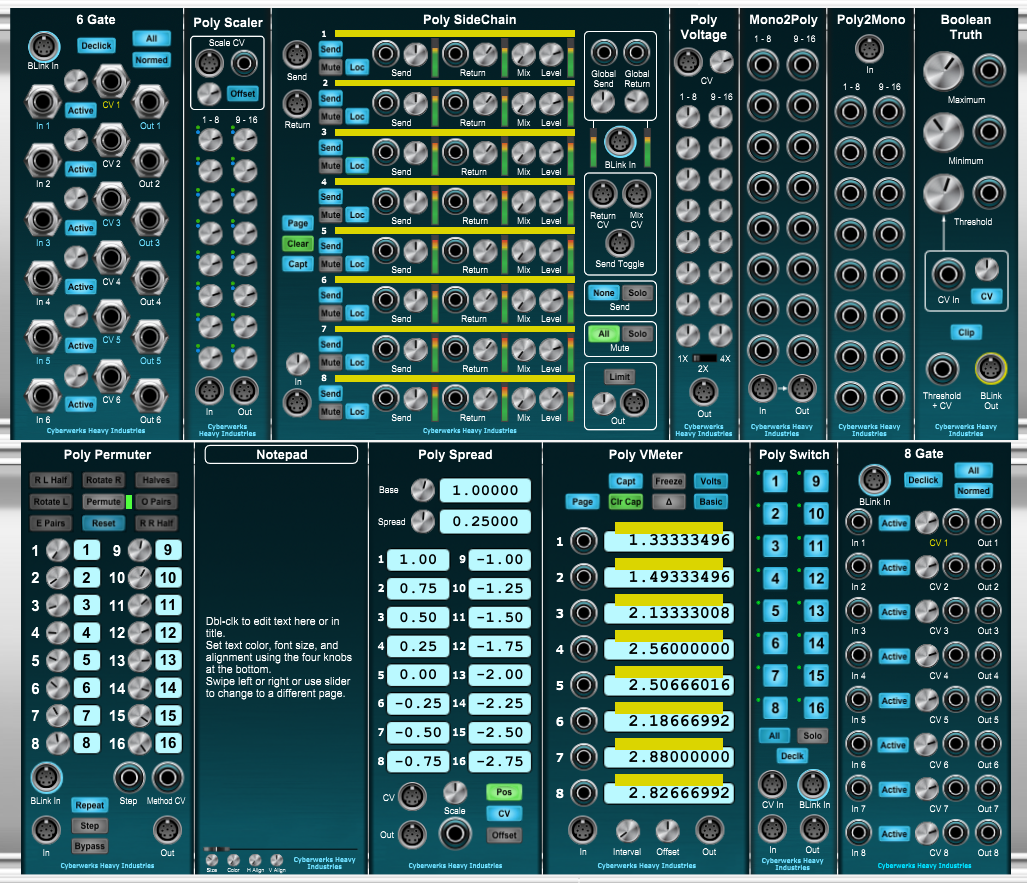Or Get It As Part of The First Baker's Dozen and Save $25
Manufacturer: Cyberwerks Heavy Industries
$7.50 $15.00
Or Get It As Part of The First Baker's Dozen and Save $25
Poly SideChain
Poly SideChain is, essentially, the local and global effects sends of a mixing board applied to the sixteen channels of a polyphonic input.
The polyphonic signal input and output jacks are located in the bottom left and right of the module, each with its own level control capable of zero to 200% adjustment. The remainder of the signal path is contained in the array of controls in the center of the module. Although it may appear that there are only eight channels present, they're actually arranged in two banks of eight; pressing the Page button toggles between the unique controls, meters, and jacks of the two pages. When the button is blue, Page 1 is selected; when green, Page 2.
Each channel consists of a send and return jack, both with level controls (0-200% and -400-400%, respectively) and VU meters, and a wet/dry mix control that runs between zero and 100% wet. After that, there's a -200% to 200% level control with VU meter that gives the final channel level after the wet/dry mix. The Send button sends the input signal to the channel Send jack when pressed; otherwise, the input signal is simply passed on. The Local/Global button changes the routing of the channel from the local channel send to a global send shared by all sixteen voices. The jacks and level controls for this global send are located in the top right of the module, with their associated meters beneath that, straddling the BLink In jack. The inputs from the various channels that may be sent through the Global Send are scaled on return by the number of such inputs, so as to not overload the channel.
Instead of individual channel send and return, the polyphonic Send and Return jacks in the top left corner of the module allow for sending all channels at once to a polyphonic effect. If any individual channel jacks are also plugged in, they will take precedence over the same channels in the poly send.
Each channel also has a caption that can be set by the user. These are toggled on by pressing the Capt (for Caption) button; any caption with text entered, even a blank, will remain visible when the Capt button is again toggled off. The Clear button immediately clears all captions of text; it is always green as a visible reminder that its action is immediate and drastic.
The Send, Mute, and Loc/Glob buttons for each channel enable/disable the send, mute the channel altogether, or toggle the channel between its Local send/return and the Global send/return, respectively. In addition, at the right side of the module, the Send None/All button allows you to select or deselect all Send buttons, while the Send Solo button puts the module into Solo Send mode, where only one Send button can be selected at a time, with the initial default being that of channel 1. Likewise, the same buttons in the Mute cartouche perform the same functions for the channel Mute buttons.
Since everything possible should be voltage-controllable in Voltage Modular, there are three CV input jacks. Return CV modulates the channel return levels; Mix CV modulates the wet/dry mix; and Send Toggle toggles specific channels on or off, depending on whether or not the Send Toggle signal for a particular channel exceeds the system truth level of 2.5 Volts. If a BLink cable is connected to the BLink In jack, its (possibly modulated) truth level will be used instead.
And, as a last touch, in the event your outputs run too hot, you can toggle the Limit button above the Out jack to engage a separate, brick-wall limiter on each channel. If BLink is connected, the limiters will use its maximum and minimum values; otherwise, they will use the system-standard -5.0 V to 5.0 V.
As always, Cyberwerks stands behind Poly SideChain, as it does all its modules, with a full non-warranty of suitability for any particular purpose, and lack of liability for any losses incurred through the use of the module. Cyberwerks Heavy Industries: the last Bastion of Rugged Individualism.




















































































